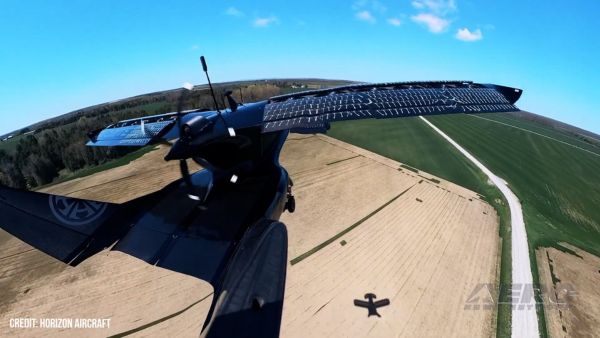Wed, Nov 05, 2003
CarterCopter Gang To Build NextGen Rotor/Prop System
It's not often that
we're pleased to hear that our government is getting ready to spend
a few more of our tax dollars... but this time, I think that we
tax-payers might actually get our money's worth.
Carter Aviation Technologies (Carter) has told ANN that it has
been awarded their first contract from the Defense Advanced
Research Projects Agency (DARPA). The contract was awarded to
support Carter's development of their next generation propeller and
rotor. Design work for the new prop and rotor has been
initiated.
This next generation two bladed rotor is designed for higher Mu
flight. It will be 45 feet tip-to-tip with 50 sq. ft. of lifting
surface and weigh approximately 300 lbs. Of that weight, 110 lbs is
inertia weights located in 'leading edge triangular deltas' at the
rotor tips. The rotor could produce 12,000-lbs of lift at MSL on a
standard day. The ratio of the rotor's weight to an 8,000-lb
helicopter would be .0375, which is only 1/2 to 1/3 the rotor
weight of most helicopters. The inherent lightweight Carter rotor
design permits using a safety factor that is higher than that
normally found in helicopters.
Carter's new, scimitar,
8-foot diameter propeller should be able to absorb 600 hp as a
2-bladed version and 1200 hp as a 4-bladed version. The highly
swept blades will permit the use of higher tip speeds, higher
coefficients of lift and thicker, more structurally efficient
airfoils without getting into critical Mach. This propeller can be
optimized for better static and climb efficiencies without losing
any noticeable cruise efficiency up through 300 mph. Weight of the
2 bladed version including the pitch change mechanism is expected
to be less than 60 lbs.
The DARPA contract is a one-time agreement to gain a better
understanding of Carter's unique propeller and rotor technologies.
The $250,000 in funding will help Carter demonstrate these
technologies and gain more test data over a wider spectrum of
performance. Carter is pleased to have DARPA interest in their
rotor and propeller technologies. After more than four years of
flight-testing with the original prototype, Carter is committed to
moving forward with its next generation aircraft and conquering
high-Mu flight.
More News
From 2021: The Inside Skinny On What Being An ANN Oshkosh Stringer Is All About By ANN Senior Stringer Extraordinare, Gene Yarbrough The annual gathering at Oshkosh is a right of p>[...]
Pilot Asked The Mechanic To Go For A Test Flight Around The Airport Traffic Pattern With Him For A Touch-And-Go Landing, And Then A Full-Stop Landing On May 7, 2025, about 1600 eas>[...]
From 2010 (YouTube Edition): Skiles Reflects On His Ring-Side Seat To An Historic Event Jeff Skiles, First Officer of US Airways Flight 1549, "The Miracle on the Hudson," was the g>[...]
“The FAA conducted a comprehensive safety review of the SpaceX Starship Flight 8 mishap and determined that the company has satisfactorily addressed the causes of the mishap,>[...]
Fuel Remaining A phrase used by either pilots or controllers when relating to the fuel remaining on board until actual fuel exhaustion. When transmitting such information in respon>[...]
 Oshkosh Memories: An Aero-News Stringer Perspective
Oshkosh Memories: An Aero-News Stringer Perspective NTSB Prelim: Diamond Aircraft Ind Inc DA 40 NG
NTSB Prelim: Diamond Aircraft Ind Inc DA 40 NG Classic Aero-TV: US Airways Jeff Skiles-Making History and Looking To The Future
Classic Aero-TV: US Airways Jeff Skiles-Making History and Looking To The Future Aero-News: Quote of the Day (05.26.25)
Aero-News: Quote of the Day (05.26.25) ANN's Daily Aero-Term (05.26.25): Fuel Remaining
ANN's Daily Aero-Term (05.26.25): Fuel Remaining


